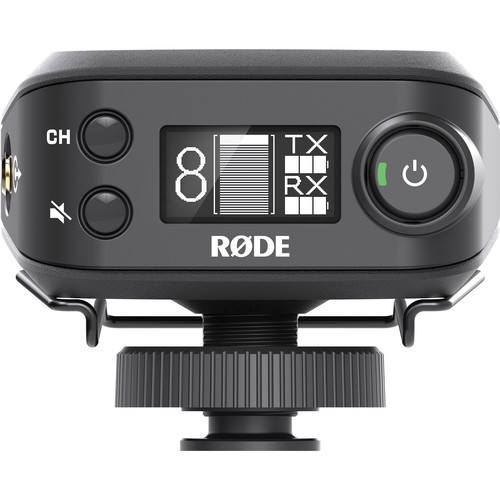RODELink News Shooter Kit Pricing
RODE's new RODELink News Shooter kit has gone on pre-order over at B&H Photo and it looks like pricing will be $499 per kit. That strikes me as a fair price for the quality and value we're accustomed to seeing from RODE.
Looking forward to getting a copy for review some time in November.
RODELink Wireless Lavalier System Review
It's been a lot of work, but here it is, finally: My review of the RODELink Filmmaker Wireless Kit. What do I think overall? This is a good balance of quality for the price (launched at $399 USD).
Pros:
- Digital signal does not drop when working within 50 meters in any of the tests I did, even outdoors and in WiFi heavy offices (because WiFi uses the same frequency in many cases).
- Battery life - lasted 7 hours and 10 minutes on a set of eneloop AA batteries (and this set is about 3.5 years old and has had a lot of use in photo flash units and audio recorders). This is much better than I expected.
- Very simple setup
- Can use up to 8 kits simultaneously
- Good audio quality
- No annoying external antennas
- No latency issues so audio stays perfectly in sync with the video captured by your camera
Cons:
- Plastic body and receiver packs (though it is good quality plastic, it is still plastic)
- Body and receiver packs are a little larger than most others in a similar price range (Perhaps this is the tradeoff for no antennas). Not a problem when mounted on someone's belt behind them but potentially a little more tricky for mounting on brides
One thing that took me a while to figure out is that the mic that comes with the kit sounds a fair bit better when hidden under the shirt of your talent. It seems that it really was made to be hidden vs worn on the outside of clothes. That would explain why they call it a filmmaker kit and not an ENG kit. I just use the RODE Invisilav to make it super simple to mount the mic under the talent's shirt.
Also, it can be used with any mic with a 3.5mm mini stereo jack (TRS) like the RODE VideoMic Pro. So you can even have a wireless shotgun microphone!
RODELink with Multiple Transmitters?
The question has come up several times now, "Can you transmit from two mics and transmitters to a single receiver with RODELink?"
Short answer: No.
There are wireless systems where you can transmit from multiple body packs to a single receiver, but the receivers are large, usually metal case deals that would not be fit for rigging on a camera and they usually include an AC to DC power brick adapter. These are really designed for live sound and concerts.
The RODELink, just like all the other wireless systems designed for film, video, and ENG are designed to work in the field without AC power and to be small enough to rig on a camera if you're using one or two units.
So, if you're shooting an interview, you will need two kits, each with a transmitter and receiver. But then the question becomes, how do you get the signal from two receivers into your camera that only has one 3.5mm TRS mic input? (often these are referred to as stereo minijack inputs - same thing)
There are probably a lot of other ways, but I use my Tascam DR-60DmkII instead of my camera. But even this only has one 3.5mm input. Not to worry, RODE offers a 3.5mm to XLR adapter for this very purpose! They call it the VXLR adapter and it allows me to plug two RODELink receivers into the two XLR inputs on the DR-60D.
I usually just record the audio with the Tascam and then sync the sound with the video in post. But some people hate doing that and are willing to sacrifice 24 bit audio for 16 bit camera audio. And I get it, there's plenty of debate out there as to whether 24 bit is all that critical. For the record, I always record 24 bit. I'm not saying you have to but here's my reasoning: It uses up very little space relative to high bit-rate video and gives me more latitude to clean things up in post. And for those that argue it doesn't make a difference in post, I'd love to see a specific, compelling example you can show to prove that. Also, syncing in post is really easy. If you're doing a ton of clips, yeah, that's harder and maybe in that case you need Pluraleyes (software from Red Giant that automatically syncs all your audio and video clips from a shoot) to do that for you.
But if you just cannot bother with all that, you could just run the signal out of the Tascam's output to the camera's mic input and then you're all set!
Someone also asked if they could just use a 3.5mm splitter to get the signal from the two receivers into the camera. In theory that should be possible. Of course you're back to using the camera's preamp (which is pretty poor quality with most cameras that have 3.5mm inputs) and 16 bit audio for most cameras. So, your results may be less than optimal.
If this is your first exposure to the RODELink wireless mic system, we've done a couple of video episodes on it so far that you might find interesting:
RODELink Distance and Interference Tests
One of my biggest concerns when I first heard about the RODELink wireless lavalier system was how well they would hold up in environments with a lot of potential interference, like corporate offices with lots of wifi network activity. Also, I was curious to learn how well it would perform when you use two kits simultaneously. So in this episode we put the RODELink to the test in two scenarios: First, we have our actors walk around a corporate office away from the receiver unit until we experienced the signal dropping. We also recorded a mock interview with two kits in a wifi heavy office building. Let’s see how RODELink held up!
(Pretty well, it turns out)
RODELink Wireless Audio: Initial Test & Overview
https://youtu.be/o6P59ZxpANI You voted that you wanted a review of the RØDELink wireless audio system a few months back and here is the initial test as I put together the full review over the next few weeks. So far, this system looks like a nice fit for enthusiasts and pros working with small crews. One thing that really impressed me was that the Filmmaker kit comes with the RØDE Lavalier microphone which on its own is normally a $250 US microphone which is more than half the price of the filmmaker kit. In my initial tests I have not experienced a single drop out though admittedly, I haven’t yet stress tested it by taking two units into a heavy wifi environment (that’ll come in the full review). So I hope this whets your appetite while I work on the full review.
My initial impression is that the RODELink Filmmakers Kit hits a very nice combination of price to build and audio quality. We're planning some stress tests (throw a bunch of wifi at it and record with two transmitters and receivers in an interview, distance) and should have the full review up in another couple of weeks. Let me know if you have any questions you would like answered specifically!
Thanks for the Feedback!
 Wow! Over 90 responses to our last episode where we asked what you wanted to learn about next. And the funny thing? The answer is pretty much, "Yes, all of the above!"
Wow! Over 90 responses to our last episode where we asked what you wanted to learn about next. And the funny thing? The answer is pretty much, "Yes, all of the above!"
So that's good news to me. It means that all these ideas I've had running through my head are pretty much in line which what you all would like to cover!
We have the first one on order: the RØDE NTG4+. It should arrive some time in March and we should have that review posted somewhere near the end of the month.
Then in April we should see the RØDELink wireless lavalier system. This one is quite interesting. I don't think we'll see pros that work in certain situations move to this new kind of wireless system right away, but maybe I'm wrong about that. What makes this different is that it uses the 2.4Ghz range, the same range that most WiFi networks use. The other wireless systems on the market that have been in use for many years use UHF frequencies. Apparently, the FCC in the US is looking at re-allocating some of those frequencies to other purposes so its going to be rough for some in the next little bit.
With these new wireless systems that use the 2.4Ghz range, on the other hand, you have to potentially worry about interference from WiFi and other consumer electronics (like cordless phones) interfering.
Ty Ford recently posted a test he did with a similar system: The Audio Technica System 10 wireless lavalier system which recently introduced a DSLR receiver for their kit which retails for around $450 USD. The main down-side to the Audio Technica System is that it doesn't use a standard plug for the mic so you're committed to using AT's mics.
In any case, Ty said that he was able to shoot several hours with the AT system 10 and did not have a single drop-out. That's pretty impressive.
But before we completely nerd out on audio gear again, we'll first cover the Atomos Shogun. Again, not a full review because there have been a bunch of those already. But more a discussion on what it does for one's workflow. I'm finding that 4k is a lot more expensive than just buying a Panasonic GH4...
And of course Audition and Resolve were popular votes as well. We've got plenty to cover there as well as we dive in and learn more on the audio and color fronts.
So thanks again for your input! We've got lots of exciting things to cover in the next few months!







 Support Me on Ko-fi
Support Me on Ko-fi
